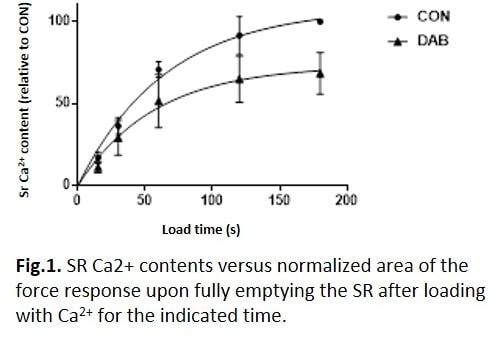Introduction. Muscle endogenous glycogen represents a primary fuel source during exercise, and the relationship between glycogen and endurance exercise capacity is a fundamental concept in exercise physiology (Bergström et al, 1967). Studies on both rodent single fibers and humans have pointed to a modulating role of glycogen availability on SR Ca2+ release rate (Ørtenblad et al, 2011, 2013). However, little is known about the role of glycogenolytic derived ATP on SR Ca2+ uptake. Methods. In order to test the role of glycogenolytic derived ATP on SR Ca-ATPase function, single fibers from rat fast-twitch muscle were mechanically skinned, thereby permitting estimation of SR, under conditions with constant cytosolic [ATP] and [PCr]. The SR of the fibre was first completely emptied of its endogenous Ca2+ by exposure to a solution with low Mg2+ and high caffeine (30 mM) and 0.5 mM EGTA, with the time-integral (i.e. area) of the force response being indicative of the amount of Ca2+ released. The SR was then reloaded with Ca2+ to various levels (by exposing to a load solution at pCa 8.0 for different load times (15, 30, 60, 120 and 180 s, respectively) before being emptied again. In each fibre, responses were normalized to that observed with the longest loading time at both control situation and after treatment (i.e. GP inhibition or amylase treatment). Glycogenolytic derived ATP was selectively inhibited by using GP activity inhibitors DAB (2 mM) or CP-316,819 (10 µM), or the glycogen was removed using glucoamylase (GA). Results. There was a clear and pronounced treatment effect (P<0.0001) of Inhibiting GP and GA treatment, decreasing maximal SR Ca2+ contents 46% (CP, n=7); 25% (DAB, n=9) and 24% (GA, n=8). With the lower maximal SR Ca2+ content, the time to reach half maximal content was significantly shorter for all treatments (P<0.01). However, total Ca2+ loaded for all load times were significantly decreased (P<0.01). Conclusion. This study provides direct evidence that glycogenolytic derived ATP is vital for normal SR Ca2+ uptake rate and maximal content, even in the presence of high global muscle ATP and aerobic metabolism.
Physiology 2019 (Aberdeen, UK) (2019) Proc Physiol Soc 43, PC188
Poster Communications: Skeletal muscle sarcoplasmic reticulum Ca2+ uptake preferentially use glycogenolytic derived ATP
N. Ørtenblad1, M. R. Kristiansen1, J. nielsen1, R. Jensen1
1. Department of Sports Science and Clinical Biomechanics, University of Southern Denmark, Odense M, United Kingdom.
View other abstracts by:
Where applicable, experiments conform with Society ethical requirements.

